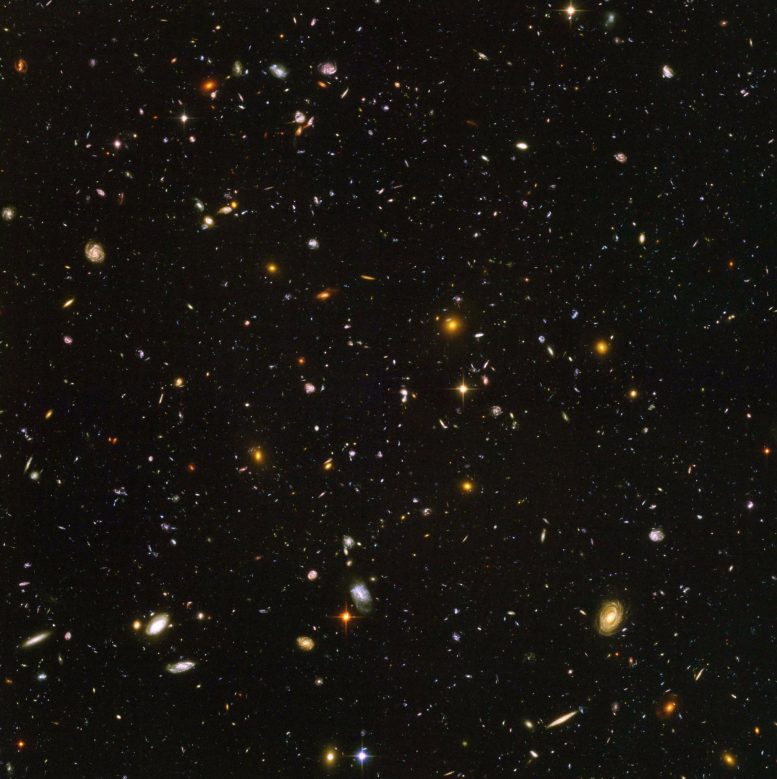
The universe is about 13.8 billion years old, and its stars are arguably its most momentous handiwork. Astronomers studying the intricacies of star formation across cosmic time are trying to understand whether stars and the processes that produce them were the same when the universe was younger, about half its current age. They already know that from three to six billion years after the big bang stars were being made at a rate roughly ten times faster than they are today. How this happened, and why, are some of the key questions being posed for the next decade of research.
Star formation in a galaxy is thought to be triggered by the accretion of gas from the intergalactic medium (gas accretion via mergers between galaxies is thought to play a relatively minor role in the total number of stars produced). In galaxies that are actively making stars, there is a tight relationship between their mass in stars and their rate of forming new stars, and this relationship approximately holds not only locally but even back when the universe was billions of years younger. In contrast, galaxies that are undergoing an active starburst – or the opposite, the quenching of star formation – fall above and below that relation respectively. The relationship supports the general picture of galaxy growth by gas accretion, except that for some reason smaller galaxies – those with fewer than about ten billion stars – seem to make slighter fewer stars than expected for their masses (the Milky Way is right at the turnover, with about ten billion stars and a rate of roughly one new star per year). A particularly significant consequence of this paucity, if real, is that simulations of galaxy growth do not show it, implying that the simulations are incorrect for smaller galaxies and that some physics is missing.
CfA astronomer Sandro Tacchella is a member of a team that used the Multi Unit Spectroscopic Explorer instrument on the VLT (Very Large Telescope) to obtain optical spectra of galaxies in the famous Hubble Deep Field South image of galaxies. They measured stellar emission lines in 179 distant galaxies in the field and used them to calculate the star formation behaviors after corrections for effects like dust extinction (which can make some of the optical lines appear weaker than they are). The find that the puzzle of depleted star formation in small galaxies is real at a level of roughly 5% even when accounting for noise and scatter in the data caused, for example, by galaxy evolution effects. The authors suggest that some kind of previously unaccounted for feedback may be responsible.
Reference: “The MUSE Hubble Ultra Deep Field Survey XI. Constraining the low-mass end of the stellar mass – star formation rate relation at z < 1” by Leindert A. Boogaard, Jarle Brinchmann, Nicolas Bouché, Mieke Paalvast, Roland Bacon, Rychard J. Bouwens, Thierry, Madusha L. P. Gunawardhana, Hanae Inami, Rafaella A., Michael V. Maseda, Peter Mitchell, Themiya Nanayakkara, Johan Richard, Joop Schaye, Corentin Schreiber, Sandro Tacchella, Lutz Wisotzki and Johannes Zabl, 7 November 2018, Astronomy & Astrophysics.
DOI: 10.1051/0004-6361/201833136
Never miss a breakthrough: Join the SciTechDaily newsletter.
8 Comments
Well. IF the production of bh/magnatars was set at the very beginning, and after several billion years no bh/magnetars were created, then the available material was being directed to the production of smaller stars.
That would fit the available data, no created bh later, and lots of sun-type. Science says 3% bh and 97% sun-type that Helium Flare into white dwarfs.
“Jumpin’ Jack Flash,
it’s a gas.”
Mankind represents “billions of, homo sapien colored, points of perception” in the conscious universe. How the universe is perceived is directly related to how and why that is being done. Thinking is optional.
Milky Way is thought to have between 100 billion and 250 billion stars, not 10 billion as listed in the article.
how the hell can you say the universe is 13.8 billion years old?! How could you possibly know?! Such lying! All to deny the reality of a creator! We must all be just dust in the wind! We just must be!!
I’m with you Larry. Where is the “clock” that determines the age of the cosmos? And look too at all the variety of designs found in those billions of galaxies. Somebody please tell me how gaseous material came together to form both a galaxy and all the stars nesting in it. And all that space between galaxies – shouldn’t it be filled with gaseous debris? Turns out the space between galaxies in virtually empty. God indeed did some fantastic handiwork, but few give Him the credit.
Larry wake up and smell the SCIENCE
Maryann: Wake up an find the creator. The beauty of His handiwork is everywhere from the smallest life form to those giant galaxies.